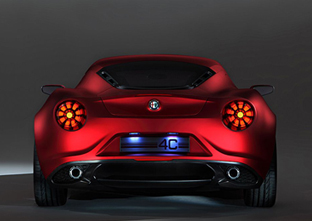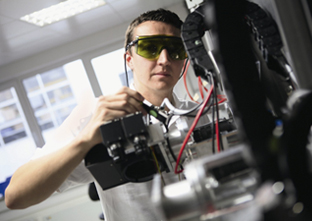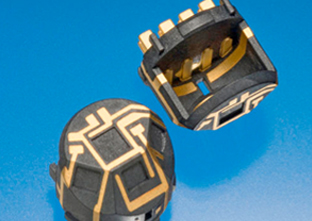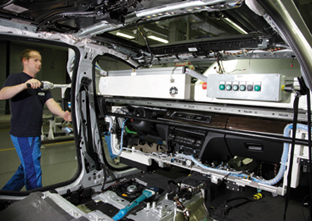
Research departments get busy
It’s getting hot under the bonnet !
Polymers also have a role to play in the engine compartment, and it is there that the most significant new developments are taking place. Because, obviously, an engine gets hot. Some parts can reach more than 200° C. But these peak temperatures do not intimidate polyetheretherketone (PEEK), a material capable of resisting temperatures close to 500° C. And that is not all, for it also has tribological properties that are particularly suitable for the automobile industry. What on earth is tribology? It is the science that studies the phenomena related to friction, wear and lubrication. We can understand why PEEK is perfectly suited to clutch and brake systems.

Some sun on the roof

From now on, designing a solar panel will be almost as easy as printing out a piece of paper! We are of course exaggerating slightly. But, only slightly. Thanks to what is now known as “thin film” technology, the solar cells are printed directly onto a plastic film. All that remains to be done is to place it on top of the vehicle and connect it to the car’s electrical system. Discrete, efficient and inexpensive, this new technology will allow a reduction of about 15% in energy costs related to air-conditioning. Provided, of course, that the air-conditioning is usually operating when the sun is shining! It is even possible that this system will one day partially supply the battery, making battery failures a thing of the past.
Exceptionally well moulded composites
 These materials have all the advantages, at least in theory. They are light, resistant, can take any shape… The only hiccough being that the manufacturing processes for these composite parts were still quite slow and expensive…were. This is another area where innovation rules. Manufacturing techniques are being further developed, and new processes allow these composites to be injected into a matrix. A reusable mould is produced into which extremely thin filaments of fibreglass or carbon are deposited, strengthened by resin. They form a sort of frame that is extremely light, flexible and very thin. Then a new layer of resin is injected into the mould. This pressurised injection procedure allows the manufacture of parts consisting of a single component. Bumper face bars, door components and chassis parts made from composite materials could thus be used on production models in the years to come.
These materials have all the advantages, at least in theory. They are light, resistant, can take any shape… The only hiccough being that the manufacturing processes for these composite parts were still quite slow and expensive…were. This is another area where innovation rules. Manufacturing techniques are being further developed, and new processes allow these composites to be injected into a matrix. A reusable mould is produced into which extremely thin filaments of fibreglass or carbon are deposited, strengthened by resin. They form a sort of frame that is extremely light, flexible and very thin. Then a new layer of resin is injected into the mould. This pressurised injection procedure allows the manufacture of parts consisting of a single component. Bumper face bars, door components and chassis parts made from composite materials could thus be used on production models in the years to come.
A high tech chassis
It’s a bit of an old chestnut now… How long will we have to wait for a chassis made from composite? These materials are a dream for manufacturers, who see them as a means of reducing the weight of a chassis by almost 50 %. This is all the more significant when you think that the chassis alone represents 25 % of the total weight of a vehicle. The entire sector is in a race to design a suitable material. Research and development centres throughout the plastics industry are beavering away on heat-hardening materials that heat up more quickly and on the development of new fibres that meet the economic demands of the manufacturers.

When plastics become intelligent
 A new science has recently made its appearance: plastronics. To give you a clue, this neologism is in fact a contraction of the words plastic and electronics and its raison d’être is to apply some intelligence to plastic materials by incorporating electronics. Nothing new there, you might think. Isn’t a simple cell phone composed of a plastic shell in which some integrated circuits have been inserted? Yes, but the difference lies entirely with this insertion: until recently, the shape of the container was largely designed in accordance with the electronic part to be enclosed. With plastronics, it is exactly the opposite; the electronics will take its place in whatever shape is imposed on it. To achieve this, it has been necessary to turn the plastic into a conductor of electricity... or almost.
A new science has recently made its appearance: plastronics. To give you a clue, this neologism is in fact a contraction of the words plastic and electronics and its raison d’être is to apply some intelligence to plastic materials by incorporating electronics. Nothing new there, you might think. Isn’t a simple cell phone composed of a plastic shell in which some integrated circuits have been inserted? Yes, but the difference lies entirely with this insertion: until recently, the shape of the container was largely designed in accordance with the electronic part to be enclosed. With plastronics, it is exactly the opposite; the electronics will take its place in whatever shape is imposed on it. To achieve this, it has been necessary to turn the plastic into a conductor of electricity... or almost.
How’s it going ?
 The principle is simple, as it consists of disposing of the electronic cards to integrate their functions directly into the interior of plastic components by creating conductive paths within the material itself. It is no longer a question of producing one part of an item in plastic and another part as an electronic element, but of producing a single object: a functional system. Now we have to reconcile the thinking of plastics engineers, who consider everything in three dimensions when they design things, with the thinking of electronics engineers, who themselves swear by two dimensions. Two dimensions, because an electronic element is usually composed of a simple board or plate with components welded on. Although it may not seem like much, this paradigm shift is breathing new life into the industry and more particularly for parts manufacturers, who can see an unprecedented mine of innovations.
The principle is simple, as it consists of disposing of the electronic cards to integrate their functions directly into the interior of plastic components by creating conductive paths within the material itself. It is no longer a question of producing one part of an item in plastic and another part as an electronic element, but of producing a single object: a functional system. Now we have to reconcile the thinking of plastics engineers, who consider everything in three dimensions when they design things, with the thinking of electronics engineers, who themselves swear by two dimensions. Two dimensions, because an electronic element is usually composed of a simple board or plate with components welded on. Although it may not seem like much, this paradigm shift is breathing new life into the industry and more particularly for parts manufacturers, who can see an unprecedented mine of innovations.
Zero defects: Utopia becomes reality
In a plastronic element, everything is integrated. There is only one part. The bell is tolling for those slow, fastidious, and not to mention, expensive, assembly operations! Gone is the welding, so often the cause of malfunctions. What is more, fewer operations are often a byword for better quality in industry. Thanks to plastronics, we are approaching the perfect zero-defects! A monobloc part of this type is also completely impervious to the many vibrations in a car. Their useful lives are substantially increased. But that is not the only matter of interest, for these objects for a new era are also much lighter. The cherry on the cake with some applications, aerials for example, is that efficiency is much improved: a 3D aerial is much more effective than a flat aerial.

Laser tattoo
 Plastronics has for a long time been restricted by its manufacturing technique, which consisted of printing conductive paths directly onto the plastic via an ink charged with conductive particles. The problem was that only some materials would accept these inks. Forward to 2008, the new technology of laser activation: laser revolutionised plastronics, opening the door to the most unlikely projects. At the moulding stage, an additive with a copper oxide base is added to the plastic. When the part has been moulded, all that remains is to activate the particles with a laser. The integrated circuits appear as if by magic. The intelligent functions of a plastic item then become infinite! In a car there are already technical parts designed with this technology: pressure sensors, control components, distance-measuring systems for intelligent cruise control, etc.
Plastronics has for a long time been restricted by its manufacturing technique, which consisted of printing conductive paths directly onto the plastic via an ink charged with conductive particles. The problem was that only some materials would accept these inks. Forward to 2008, the new technology of laser activation: laser revolutionised plastronics, opening the door to the most unlikely projects. At the moulding stage, an additive with a copper oxide base is added to the plastic. When the part has been moulded, all that remains is to activate the particles with a laser. The integrated circuits appear as if by magic. The intelligent functions of a plastic item then become infinite! In a car there are already technical parts designed with this technology: pressure sensors, control components, distance-measuring systems for intelligent cruise control, etc.
Technology at your fingertips
 Let’s face it, it has already been ages since a steering wheel was an ordinary circle that was turned to point the wheels in the intended direction. A modern steering wheel generally includes an inflatable air bag and various buttons or switches, like those for the radio, the horn, the cruise control, etc. With the arrival of plastronics, the steering wheel has become even more advanced. BMW has developed a steering wheel for one of its sports models with components that have been designed and integrated by means of plastronics. Farewell to assemblies and the delicate soldering of wires onto electronic plates, which were so often sources of waste. But that is not the only benefit. In fact, all that has to be done is to change the path of the laser in order to develop new functions.
Let’s face it, it has already been ages since a steering wheel was an ordinary circle that was turned to point the wheels in the intended direction. A modern steering wheel generally includes an inflatable air bag and various buttons or switches, like those for the radio, the horn, the cruise control, etc. With the arrival of plastronics, the steering wheel has become even more advanced. BMW has developed a steering wheel for one of its sports models with components that have been designed and integrated by means of plastronics. Farewell to assemblies and the delicate soldering of wires onto electronic plates, which were so often sources of waste. But that is not the only benefit. In fact, all that has to be done is to change the path of the laser in order to develop new functions.
This is an opportunity for the different brands to improve their flexibility, because each steering wheel can be identified in line with local preferences – European drivers like to be able to adjust their radio from the steering wheel, while drivers in North America prefer to have their cruise control functions – or even options selected by the customer. An element of customisation is now possible, even in mass-production models. We have come a long way since the time of Henry Ford, who said a hundred years ago “You can have the Model T in any colour you like – so long as it’s black!”





